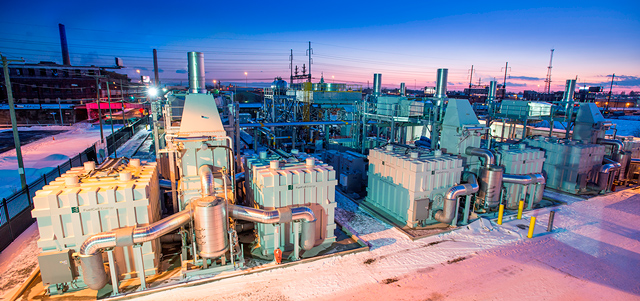Fuel Cell Technology – Powering Neighborhoods. And Your Ride. (+ late-breaking news)

About a year-and-a-half ago, the largest fuel cell generation plant in North America was unveiled in Bridgeport.
There are five FuelCell Energy DFC3000™ systems combined, called Dominion Bridgeport, producing 14.9 MW of power from the downtown Bridgeport area just off I-95. (I’ve driven by the plant several times, not paying enough attention to know what it is–or driving too fast.) About 15,000 homes are being powered with this vastly cleaner form of energy. Approximate cost to owner Dominion Resources, a major Virginia-based natural gas and electricity provider: $65M.
One very cool thing is that these systems can be decentrally located, helping cities or sections of cites to become more resilient. Resilience is catching on big-time in urban and other areas, such as Annapolis, where a wave of mitigation planning is growing around extreme weather/natural disasters such as Super Storm Sandy which can further devastate large urban areas when the grid is knocked offline. Or, sabotage of the centralized grid. (More on resilience in an upcoming post.)
In a sense, there’s a circling back. In the late 19th and early 20th c., power stations were much, much smaller and decentralized. Of course these were primarily fossil-fuel powered. As time marched on, these stations became centralized mega-stations, offering efficiency of scale. Bridgeport Harbor Power Station, for instance, can generate about 401 megawatts by burning coal. (Cough.)
The game-changers are two: cleaner fuel combined with highly efficient power generation technology. Brownfield clean-up was also in the plan for locating the Dominion Bridgeport facility in the center city.
In a fuel cell, hydrogen and oxygen are combined to form water, with electricity and heat produced in the process. That’s roughly the opposite of how direct current, called electrolysis, is produced.
The source of hydrogen is natural gas which is largely composed of methane (there are other hydrocarbons in the mix, such as propane). It can also be methane gas itself (from covered landfills–or covered cattle ranches, if you can imagine) so watch for that linkage here/there in the future. Fuel Cell Energy Inc., the developer of the FuelCell Energy DFC3000 and smaller fuel cell power systems, claims that its proprietary process can strip hydrogen from the methane molecule a lot more efficiently than other processes.
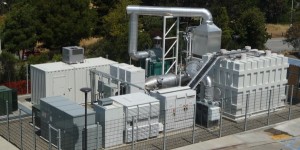
Other fuel cell micro-grids are popping up in Bridgeport. One is at the University of Bridgeport where a 1.4 MW system handles about 80% of the on-campus needs: the student center, the dining hall, the recreation center, two dormitories and the on-campus police station.
It can operate completely independent of the central Bridgeport electric grid in the event of a disruption. It’s estimated that a much at 7K tons of annual carbon emissions will be eliminated by the University of Bridgeport facility.
Turning our attention to fuel cell technology for cars, here’s the brand-new Toyota Mirai. If you haven’t bought yours yet, Nancy, is it because there isn’t a handy refueling station anywhere near you?
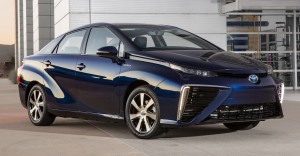
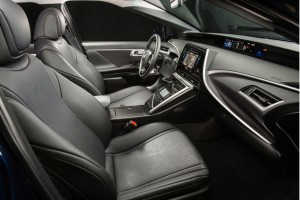 The company calls this car The Turning Point, from the inside out. The model name Mirai (未来?) means “the future” in Japanese. Claiming a turning point in automotive history it seems…
The company calls this car The Turning Point, from the inside out. The model name Mirai (未来?) means “the future” in Japanese. Claiming a turning point in automotive history it seems…
At Car and Driver magazine, the Mirai is shown with a sticker price of $58,325. (Less expensive than a Tesla.) Its review opens: “Yes, it’s ugly—spectacularly ugly. There is no single angle from which it looks anything but ugly. But there’s also no single angle from which the 2016 Toyota Mirai looks like anything else.” Trying to forgive the design, think Prius when it was first introduced, the reviewer suggests.
Hydrogen atoms fuel the Mirai. There are two tanks on board, together holding 11#s at 10K psi/ea. To learn more about the car and its propulsion system, click on this link.
What should come with the Mirai and its kind is proximity to refueling stations. There are a number in California, mapped for drivers, including one I know of near the Ontario airport serving college town Claremont and the rest of eastern LA County.
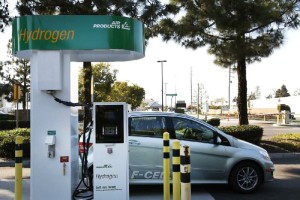
Late-breaking News-
Following Google’s lead in investing in alternative (solar) energy as per a recent post here, United Airlines just announced that it’s becoming a business partner with biofuels maker Fulcrum BioEnergy. Plan is for as many as 5 plants, where trash is turned into jet and diesel fuel, to be located near United hubs, including DC. Claim is that the trash-to-fuel can be made for less than $1/gal.
